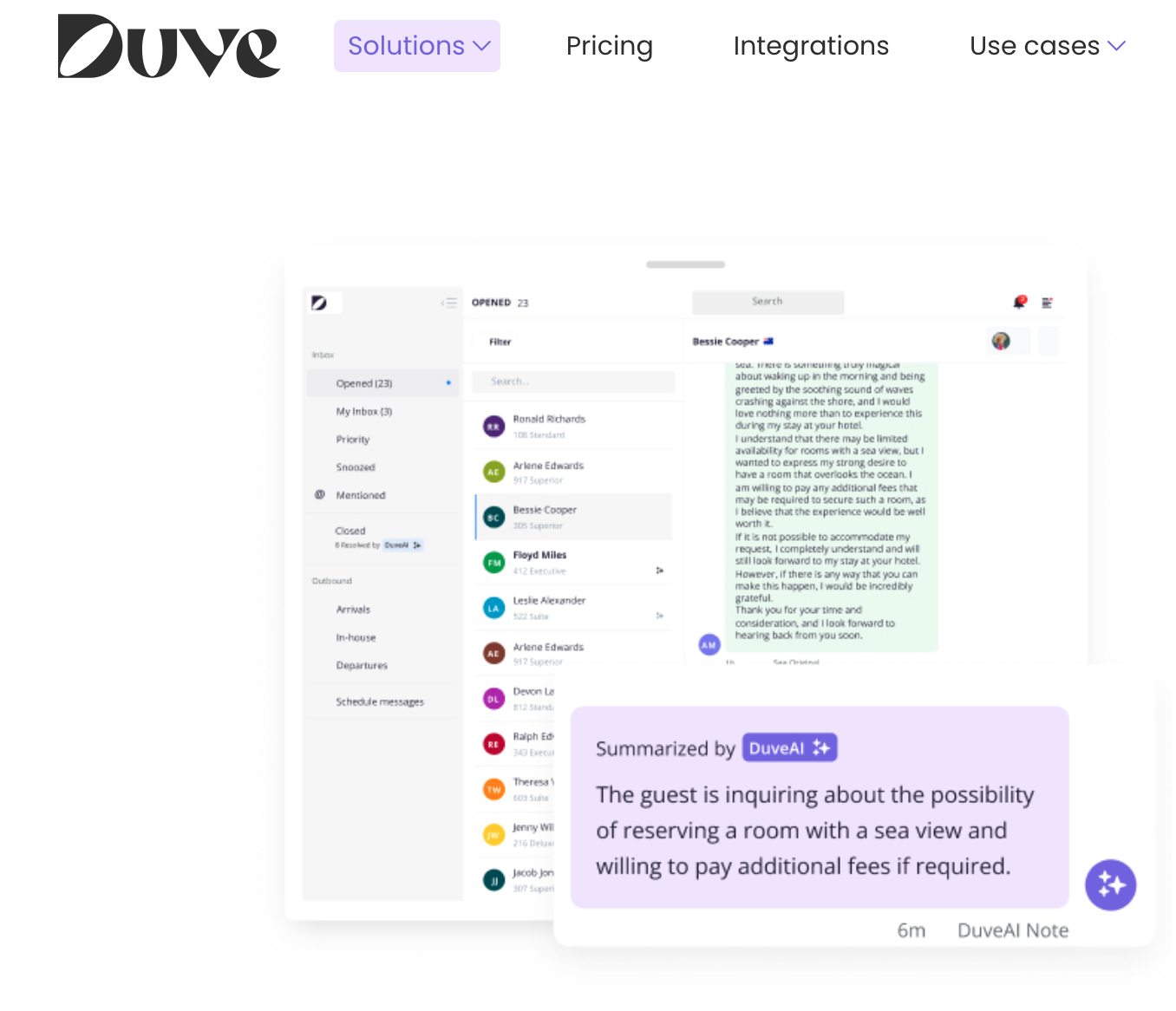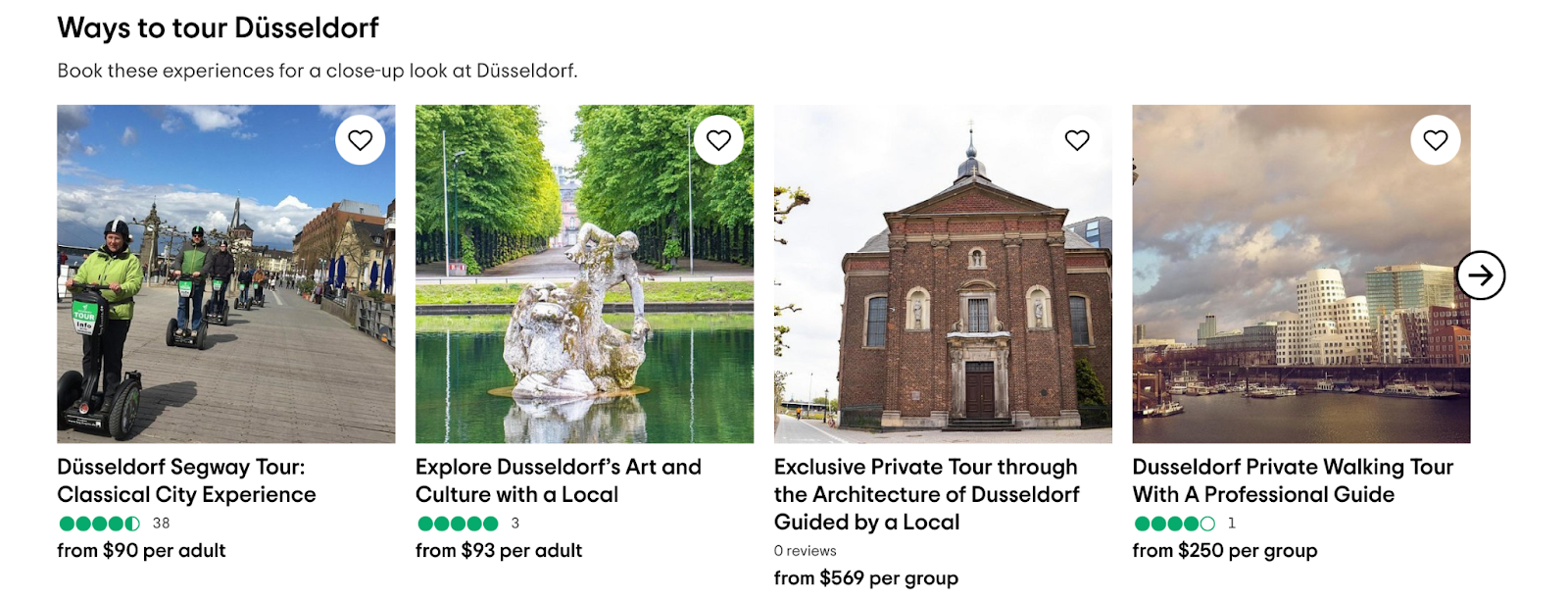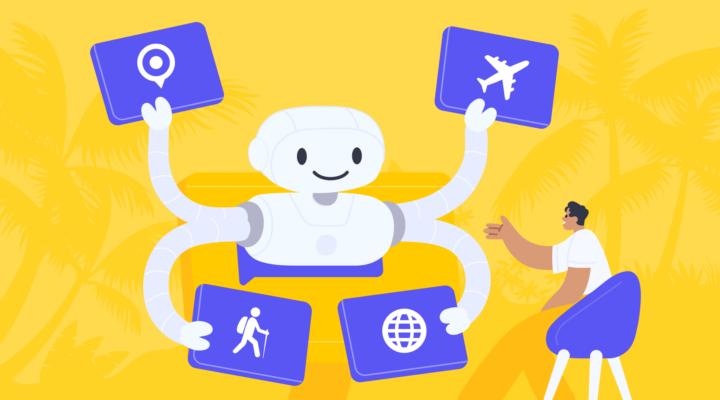Understanding AI-Driven Recommendation Engines in Travel
An AI-driven recommendation engine is a technological tool that uses machine learning to predict a user’s behavior and provide them with relevant products, services, or information. Recommendations are based on various factors, such as the history of the user, their preferences, interests, ratings, reviews, demographics, devices used to click a link, etc. In addition, AI technology analyzes the activity of similar users and suggests solutions accordingly.
Recommender systems may resemble experienced sales assistants who perfectly understand the customer’s preferences and can suggest the most desirable products, thus increasing customer satisfaction and conversion rates.
The Benefits of Personalised Travel Experiences for Bloggers and Readers
Although many still believe AI recommendation engines are too difficult to implement, most of these doubts are unfounded. In reality, AI provides several advantages for travel bloggers, brands, and customers, and can easily be added to current data processing systems. Here are the key benefits of introducing an AI recommendation system:
- Suggest relevant products and services to the traveler
- Support indecisive users by providing additional information
- Encourage users to explore new destinations based on their own preferences
- Deliver more relevant search results
- Improve user engagement on your blog
- Enhance the overall travel experience with personalized suggestions
- Increase customer satisfaction and loyalty
- Promote sustainable tourism by recommending less crowded and remote destinations
- Differentiate your destination from similar destinations
- Grow CTR and conversion rates on your blog by targeting the right audience
- Promote your latest content based on user preferences
- Boost order value and overall revenue from your blog
All in all, implementing AI recommendation engines can translate into a better experience for customers as well as more efficient data management, lower costs, higher user retention rate, and higher revenue for brands and bloggers. Besides, in times of uncertainty, such systems can also help users quickly change their travel plans and organize a nice trip to a similar destination.
How AI Recommendation Engines Work in the Travel Industry
With so many choices available, it is increasingly hard to narrow down the options and choose a single product. AI recommendation engines can meet travelers’ growing expectations by offering personalized solutions, faster customer service, forecasting, and more. In addition, travel brands and webmasters can learn from the data gathered and processed from AI recommendation engines to adjust their services and products accordingly.
For example, AI travel systems can suggest relevant destinations or hotels based on the user’s history, customer reviews, social media posts, etc. AI chatbots can instantly provide the necessary information and help users solve problems, such as find another flight or connection, on the spot. It is also possible to track bags, forecast flight delays, and perform other tasks.
Whatever task your recommendation engine performs, it operates using one or more of the following approaches.
1. Content-Based Filtering
This approach analyzes the preferences and behavior patterns of a single user and provides recommendations accordingly. Based on the user’s likes and views, the engine will suggest relevant products, services, or content. The more information about the user you gather, the more accurate the recommendations become. However, for privacy reasons, it is not always possible to accumulate much personal data. This issue is known as a “cold start” for recommender systems. In this case, content-based filtering can be combined with other approaches, such as collaborative filtering.
2. Collaborative Filtering
This technique accumulates information from other users’ interactions and delivers suggestions accordingly. It focuses on users with similar behavioral patterns, demographics, and tastes, and uses their opinions to identify products or content that those users might also enjoy. Collaborative filtering often has high accuracy, but can be ineffective if not enough data has been collected.
3. Knowledge-Based System
This is a rather expensive approach that is suitable for more complicated domains. It takes into consideration the influence of users’ needs as well as their degree of expertise and knowledge. Based on that, the system sets rules for when each recommendation can be beneficial to each user. This can take into account the user’s interaction history, expert information, and more.
Leveraging User Data for Personalization and Tailored Recommendations
To provide relevant suggestions, AI recommender systems analyze user data. The more diverse this data, the more accurate the suggestions are. Obtaining user information is key to providing data-driven recommendations and excellent services.
Here are key data points that are important for building an efficient recommendation system:
- Sign-up data on the website, such as email addresses, names of users, and other demographic details that users provide when registering. This may include their gender, age, income, education, profession, etc. This data can also be helpful for customer segmentation, when it comes to email marketing.
- User profile, which includes the history of the interactions of the user on the website. Seeing their conversations on the blog, how often they ask for support, and what frustrates them most can help users gain valuable insights.
- User ratings and reviews that help distinguish what is popular among particular users. This can also indicate whether a specific user is a novice or an expert and what kind of support they need to make a choice.
- Information about similar users and their preferences (“Users who booked Hotel XX also liked”).
To gain as much insight into the customer journey as possible, it is important to make sure your software captures data on every stage of the marketing funnel (from signing up to becoming loyal customers).
AI-Enhanced Destination Recommendations for Travel Bloggers
AI recommendation engines can help travel bloggers suggest the best destination for their readers, thus enhancing their travel experience and growing your blog conversions. Research shows that many users ask friends for advice when choosing whether or not to read/watch a book or movie. Travel planning is no exception. Thus, users will be more likely to visit a recommended place instead of a random destination.
Recommender systems can offer similar destinations based on the travel history of the user, while also suggesting less remote or expensive spots to help users save time and money. These suggestions are made based on the user’s check-in data, their friends’ information, locations visited, and more.
Curating Customized Itineraries With AI-Driven Recommendation Engines
AI-powered recommendation engines can provide customized itineraries to every user. This sort of personalized assistance can improve customer experience, reduce stress on the road, as well as help brands build a loyal community and increase conversions.
These recommendations are based on individual preferences, travel history, online behavior, and other factors. By analyzing the user’s choices of destinations, hotels, flights, activities, and so on, you can cater to each user’s unique interests and suggest a trip that will not leave even the most demanding traveler feeling indifferent. These recommendations might also include personalized discounts and make the user more likely to book. In addition, users can receive notifications from you to avoid missing any offers or important changes.
Personalizing Accommodation Suggestions for Travel Bloggers and Readers
Another way in which AI-powered systems can improve travel experiences is by suggesting accommodation options. These recommendations are based on the user’s history and preferences. For example, if the user has repeatedly chosen the same hotel chain, they will be suggested to book a room in a similar hotel in their new destination. This applies to other factors as well, such as the price range, room type, number of days visiting the area, etc.
Expedia is a great example of an AI-driven booking tool. It applies machine learning to provide personalized recommendations based on the user’s search history. The platform also forecasts potential complications during a trip and suggests solutions to these difficulties. For instance, in case of a flight delay, Expedia can provide alternative accommodation options. This makes the booking process faster and easier, especially for those without much digital expertise.
To help their audience with trip planning, brands can take advantage of a handful of AI tools. For example, Duve AI is an upcoming software that will help hotels quickly communicate with their guests. It will also summarize each message to save time for processing. In addition, all prompt answers and templates are specifically tailored to the hotel niche.

AI-Powered Restaurant and Food Recommendations for Memorable Culinary Experiences
Dining is, perhaps, one of the most enjoyable parts of any trip. As a result, recommending the right culinary experiences for your specific audience can greatly enhance their experience. It is common to ask friends and family for restaurant recommendations. In addition, users are more likely to choose a place with high ratings. An AI-powered recommendation engine can provide your readers with a wide choice of dining options in their given destinations that suit their tastes, thus saving them time and effort. These suggestions include various factors, such as favorite cuisine, dietary restrictions, customer reviews, and more. Thus, travel bloggers can help readers find the perfect meal wherever they go.
One such tool is Restaurant Recommender. With the help of machine learning, this tool provides a list of suggestions for a meal based on the user’s location. Another promising solution is the AI Assistant by OneBrain. This digital assistant promises to look through online reviews to rate restaurants and cafes based on the user’s needs. For example, it can find the best cafes with Wi-Fi, etc.
Some restaurants already use AI to create customized menus for visitors based on their individual diets, preferences, and more. On the other hand, chefs can discover the most popular choices to enhance their menu and reduce food waste.
Another way that AI can improve the culinary experiences of your audience is by identifying and promoting food-related content on social media. This will allow your followers to discover more interesting dishes and restaurants. In addition, the technology can identify ingredients in photos and share detailed information about each dish. This will help travelers learn more about the local cuisine.
Discovering Unique Experiences and Activities Through AI Recommendations
Tours and activities are a highlight of almost every trip. You can help your readers enhance their travel experience by booking relevant activities in their destination. AI-powered recommendations will be based on the user’s preferences and history and include relevant experiences, while suggesting activities that similar users enjoyed.
Tripadvisor, the world’s largest travel online agency, has integrated AI to provide personalized experience suggestions based on users’ preferences, history, and budget. Thus, when exploring a new destination, the user will see more experiences similar to the ones they liked before.

Enhancing Travel Planning With AI-Driven Transportation Recommendations
There are also many ways in which AI recommender systems can enhance the transportation experience of your readers. For example, these algorithms can predict the lowest prices for the destination of the user’s choice. So, when researching flight tickets, the user will see recommended dates with the best price and will be more likely to book a trip. Travel brands, such as Hopper and Kayak, use machine learning to analyze historical flight prices and predict the best dates for the user.
Another benefit of AI-powered recommendation engines is that they can help the user build a seamless travel itinerary and calculate the fastest route to the destination. This is especially important when the user wants to combine different modes of transportation, such as airplanes, buses, trains, etc.
AI-Enabled Recommendation Engines for Travel Blog Readers
Integrating an AI-driven recommendation engine can also skyrocket your travel blog and enhance the user experience. First, it can suggest content based on the reader’s preferences and reveal the most relevant posts that may be hard to find otherwise. Thus, you can promote your content to the best extent possible while driving traffic to all your blog posts.
Second, AI can help the user plan their trip right on your blog. Based on their history and preferences, the engine will suggest relevant destinations, activities, accommodations, and transportation options. This will facilitate the entire planning process, so the user can book the perfect vacation in a single click.
Third, depending on your niche, you might want to recommend different offers to different users, especially if your blog targets a wide audience. Knowing the user’s interests, the system will suggest a product, service, or information, accordingly. This will increase the conversion rate and reduce the bounce rate.
Incorporating User Feedback and Ratings in AI Recommendations
User feedback and preferences can help AI recommendation engines understand your audience better and provide more relevant suggestions in the future. Essentially, the feedback you gather from your readers can be both explicit and implicit. Explicit feedback includes ratings and reviews that customers directly leave on your site, while implicit feedback refers to user behavior and actions on the page. While implicit feedback can be gathered automatically, you need to ask your readers to leave a rating or review to obtain explicit feedback. From there, the system can use all the feedback to update user information in the database and optimize its next suggestions.
To make sure your recommendation system effectively processes user feedback, it is crucial to relate to the user’s specific context, pain points, and goals. In addition, it is paramount to guarantee data privacy and respect the user’s control over their data.
Conclusion
While the integration of AI in the travel niche is still just beginning, it holds a huge potential. This might be the best time to follow the example of the travel giants, such as Expedia, Kayak, and Tripadvisor, and integrate an AI-driven recommendation engine into your own travel blog. This will require some effort on your part, but in return, will ensure flawless data procession and next-level personalization for your blog readers.
To make sure your travel blog offers the most relevant experiences to your readers, join Travelpayouts and promote over 100 travel brands, such as airlines, hotels, tours and activities platforms, trip insurance providers, and more. You can also earn unlimited affiliate commissions and help your audience organize seamless trips.



